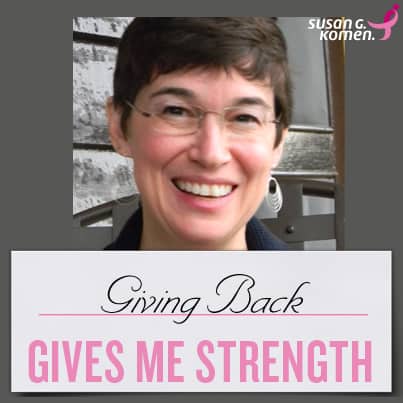Debbie Woodbury
Survivor

Do you recognize that feeling of walking through life trying to function and look okay, but on the inside being a complete mess? That was me during most of 2009.
That February, a breast cancer diagnosis had gone off like a bomb blast in my life. After five months of mammograms, stereotactic and surgical biopsies, tests and doctor visits (and not a single lump) we were shocked to learn I had Stage 0 DCIS (ductal carcinoma in situ) breast cancer.
In April, I had a unilateral mastectomy and TRAM flap reconstructive surgery. I was scheduled for a second reconstructive surgery in September, but “the worst was over” and I fully expected survivorship to be a celebration.
It wasn’t. Every time I stepped out of the shower, my fifteen inch hip to hip scar, missing nipple and asymmetrical, scarred breasts screamed “DAMAGED” at me. Although I tried to hide it, my body image, sense of wellbeing and trust in my own body were fractured. Emotionally, I was angry, fatigued and teetering on depression.
While my family and friends were incredibly supportive during treatment, once the mastectomy was behind us, they eagerly returned to life before cancer. I wanted to join them, but it was impossible and I found myself alone, facing an unrecognizable “new normal.”
Of course, I didn’t know post-traumatic shock was a normal part of the cancer experience. (And, I certainly didn’t feel entitled to my emotions given a Stage 0 diagnosis and the blessing of no chemotherapy.) All I knew was that I was lost and broken.
Although I didn’t recognize it at the time, my salvation started two days after my mastectomy when a breast nurse navigator walked into my hospital room and introduced me to the world of cancer support services.
Desperate, I committed to weekly meetings with a therapist. With her support, I joined support groups and a rehabilitative exercise class. I took every opportunity to meet and connect with other survivors who “got it” and started to heal and feel less alone.
Then one day I walked into an American Cancer Society “Look Good … Feel Better” program and sat next to a woman wearing a wig. Her hair was growing in, but still very short, and she was anxious about going without her wig in public. We encouraged her to take it off if she was ready. She decided she was and removed it for the first time in front of anyone other than her husband.
We were amazed at how chic she looked! I have short hair by choice and told her how much I genuinely loved her hair. Because she wasn’t used to having short hair, she was floored by our reaction and, for the first time in a long time, saw herself as beautiful.
We kept talking and I encouraged her to walk out of the room without her wig. She was self-conscious, but ready, and I walked with her for support. We talked about therapy, which she was considering, but reluctant to try. I told her how vital it was to my healing. With my support, she made an appointment that day and she never put that wig back on her head.
Supporting someone else was the beginning of the end of my cancer depression. For the first time since cancer came into my life, my experience was useful because I used it to give back in service to a fellow survivor.
Because giving back gives me strength I went on to create my website for survivors, WhereWeGoNow, and become a motivational speaker. My two books, You Can Thrive After Treatment and How to Build an Amazing Life After Treatment, share simple tips you can do right now to create inspired healing, wellness and joy beyond cancer.
I’m also a support volunteer with The Cancer Hope Network and a patient educator with the Pathways Women’s Cancer Teaching Project. You can connect with me at WhereWeGoNow, and on Twitter and Facebook.
It’s a gift to give back in gratitude for all the support I got when I needed it. As Maya Angelou said, “I have found that among its other benefits, giving liberates the soul of the giver.” Giving back gives me strength and liberated my soul from cancer.
